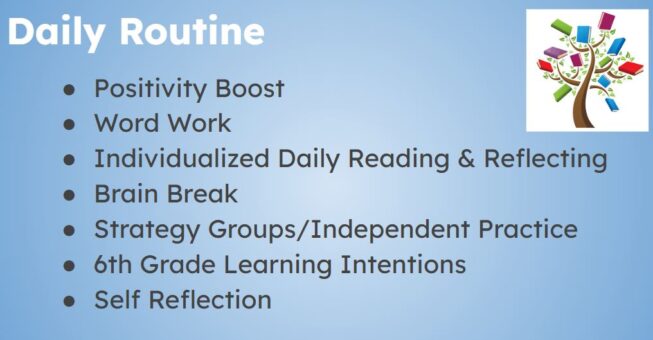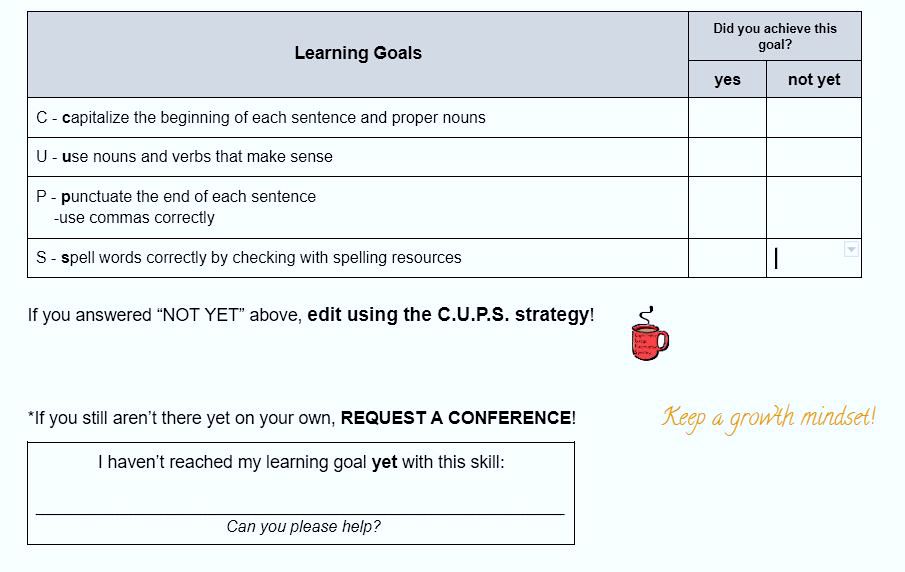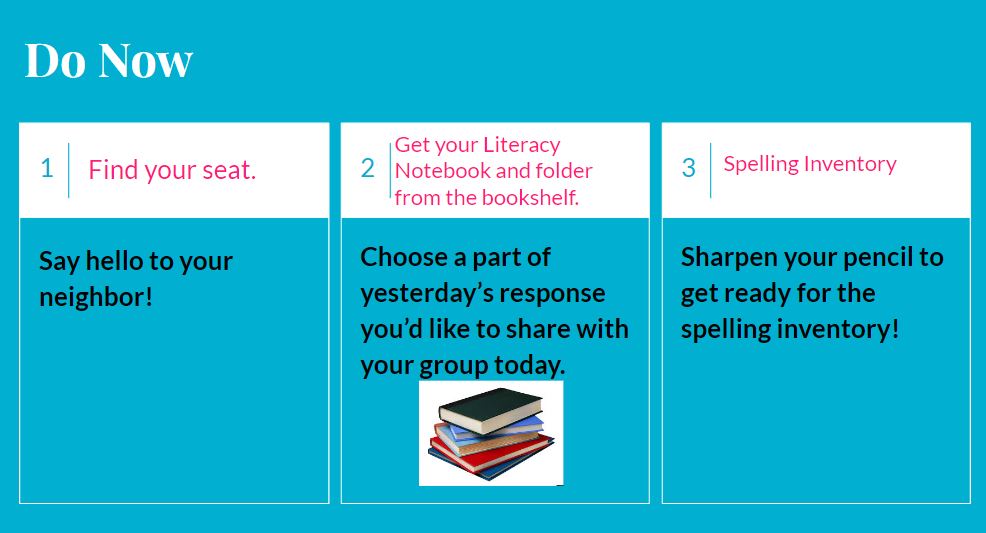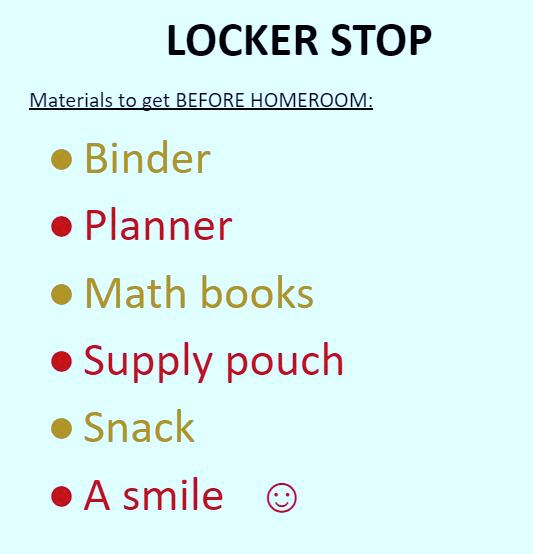Reassuring Routines Build Student Confidence
In a new MiddleWeb series – UN-to-RE – teacher Kelly Owens shares tips that can strengthen teaching and improve achievement. “As you self-reflect after a long teaching day, unit, or extended break,” she writes, “this series will deepen your reflections about what needs UNDOING and present ways to RESET for greater student success.”
Kelly’s first article focuses on ways teachers can help students take ownership and responsibility by minimizing the UNEXPECTED and offering REASSURING routines.

In spin class I amped up my pedal speed after a familiar warm-up tune transitioned into a fast-beat tempo. My instructor introduced the new tune by saying, “Comfort is nice, but nothing grows there.”
That stopped me in my tracks. He was right. I had been lost in my own world, engaged in a comfortable task, not even thinking about pedaling as I warmed up.
The gentle flat ride ensured my muscles were warm and my bike was well adjusted. Once the sprints and hills kicked in, I became aware of my posture, tempo, and resistance changes. My focus sharpened. Now I was outside my comfort zone – and challenging myself to grow!
My predictable warm-up was necessary and served a purpose. But the real learning occurred once I was primed to explore more challenging rides and push myself to my potential. The expected preparation time in my comfort zone got me ready to turn my attention to the challenging learning laps that grew my athletic skills.
Students Should Spend Time Both In and Out of Their Comfort Zones
Students in our classrooms also need expected routines that become second nature and don’t require much conscious thought. Imagine the mastering of routines as “going on autopilot.” When they reach this point, students are ready to focus on the important work of learning and growing. They’re ready to go outside their comfort zones and challenge themselves.
In this post let’s look at the ways we can make routines second nature and consider all the benefits of investing some time in routine-building.
Learning Inside the Comfort Zone
Comfortable routines should be linked to learning goals, so students and teachers can function as seamlessly as possible in a classroom community. Students should understand how routines set them up for success in the less concrete and defined explorations of new learning.
We want students to focus their brainpower on challenging new experiences outside their comfort zones – not on logistical classroom routines. When we help them master reassuring routines, we create safe spaces for students to assume responsibility. As they gain confidence, students are primed to enter a zone where they are ready and able to learn hard things.
Social-Emotional Benefits of Expected Routines
The time invested in teaching, modeling, practicing, and reinforcing routines has a variety of social-emotional learning benefits:
- Familiar routines ease anxiety and make you feel safe.
- Predictability puts you in a positive mood and sets the tone for the rest of the class.
- Students feel confident and in control.
- Classmates collaborate as they work toward a common purpose.
- Clear expectations eliminate uncertainty.
- Routines help build a respectful, inclusive class community.
- Students boost their self-esteem knowing they can navigate on their own.
Classroom Management Benefits of Expected Routines
Likewise, a classroom with established routines can proactively prevent problems because there are fewer opportunities for unexpected events to occur.
When routines are in place, we:
- Eliminate confusion or students wondering “What do I do?”
- Minimize lost instructional time caused by unanticipated “logistics”
- Have fewer instances of running out of time to complete tasks
- Have fewer disruptions because students don’t have to ask others what to do
- Grow increasingly independent students who are more focused
- Support a more student-centered classroom culture
Once they understand our purpose, students come to expect routines and follow them on autopilot. After three days of teaching a recent summer session, I no longer had to take time to retrieve students’ folders, books, and sticky notes from the side table. Without any prompting, several students entered the room and automatically walked over to get the supplies and distribute them to classmates.
Their actions showed they were ready to learn and thanks to their internalizing that routine, we had more time to learn!
Types of Reassuring Routines
Every classroom is different, but each one needs tailored routines to help it function in a positive and productive manner. We can group routines into categories like these:
Administrative routines
Plan ahead for what students should do as you take attendance. Do you want them to move their personalized magnetic name card on the board or do you verbally take roll? Think about how and when students should use the pencil sharpener or whether you want to have a few pre-sharpened pencils available to swap. Administrative routines are part of teaching, and we are always looking for more time. Pre-planned routines can minimize the impact of these necessities on teaching time.
Instructional routines
Think about the flow from one teaching format to another. How should students progress from whole-class discussions to tables to small strategy groups? Transition times can be unstructured times that eat up minutes if routines and clearly stated behavior expectations aren’t established.
Response routines
Keeping all students actively engaged in large whole-class discussions is challenging. What type of signal do you want students to use so you gain their attention? Long ago, I used the rhyming phrase “freeze please” to gather a group’s focus. Years after that, I taught students to use clapping and snapping motions to unite the class. My choices changed to match the personalities of my classes. Consider what works best for your students.
Material routines
When students complete work, where should they turn it in? Clearly labeled and visible bins help remind students of the expectations in your particular classroom. Quick dropoff points help the classroom function with minimal disruptions and support a focus on the learning process.
Model, then Make Routines Visible
Just like any taught skill, routines need to be taught, modeled, practiced, and reinforced. Students deserve lots of praise when they begin owning routines and applying them without reminders.
To help scaffold the learning of routines, it helps to make them visible. Printed routines allow students to refer to them independently. No teacher prompting required – which frees you to spend more time in meaningful instruction. Here are some ideas:
Project the daily routine for the class to see and share the document electronically with your students. Alternatively, dedicate bulletin board space to your daily routine. The more students see it, the more they will remember it!
The writers’ self-evaluation checklist spells out the instructional routine to initiate a student-teacher conference. This routine is linked to the learning goal of the writing process lesson.
A Do Now slide guides students through a response routine and then segues them to a material routine.
Photocopy this routine for students to post in their lockers. It helps them quickly remember the materials routine in crowded hallways with lots of distractions.
Pause-and-Think Questions for Teachers
- Consider the routines in your classroom. Which ones work well? Why? Which colleague(s) might also find them useful?
- When have you observed students being confused about what to do? Which type of reassuring routine could help?
- How can you best talk to students about the value that routines offer them? Do they have routines at home? For homework? When they get ready for school? Do routines make life more comfortable?
- Before beginning a new unit or when returning from a long break, which routines might need to be revised or replaced with new routines?
Summing Up: Shifting Classrooms from the Unexpected to the Reassuring
Unexpected flows in classrooms steal precious teaching time and lead to frustrated students and teachers. Expected routines provide comfort and familiarity so students can focus on the challenges of learning and growing.
Comfort is nice – and necessary – because it lowers stress and anxiety caused by uncertainty. Routines provide a framework, or skeleton, around which teachers can plan instructional activities.
An expected sequence of class events offers reassurance and continuity. Teachers are always looking for more time. Preplanned, explicitly-taught routines linked to learning goals provide a clear path to a clear destination – one designed for students to succeed.
PS: Time management is a life skill. Creating your own routines outside the classroom can help you balance all of your responsibilities and activities so you can more fully enjoy each of them.
Kelly Owens is a literacy interventionist who helps middle graders overcome past literacy struggles by building stamina, confidence, and a greater love of learning. As a teacher with over 28 years of experience, she has proudly represented Hillsborough Township Public Schools as a NJ Governor’s Teacher of the Year. She also co-created Buddies for the Birds, which was featured on Emmy Award-winning Classroom Close-up NJ.
Kelly earned her Ed.M. from Rutgers University. Additional writing credits include published work with The King School Series (Townsend Press), and The Mailbox magazine. See all of her posts for MiddleWeb here.






































